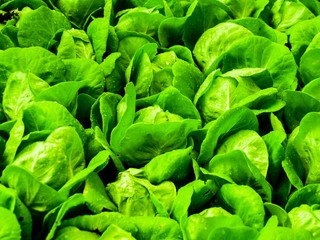How to grow fresh lettuce indoors: 4 common types

Open almost any refrigerator across many developed countries and you can place a safe bet the vegetable crisper will contain at least a single variety of lettuce in one form or another. The push towards healthier lifestyles and cleaner diets have fueled an upswing in the consumption of green vegetables, salads especially. Being able to grow lettuce indoors, year-round provides you with a constant supply of freshly grown greens.
Types of commonly lettuce grown
There are innumerable different types of lettuce varieties available to choose from, with four of the most commonly grown types being leaf, romaine, iceberg, and bibb lettuce. Choose one that you enjoy in your salad bowl or branch out by growing something you’ve never tried before.
- Leaf - Available in either red or green varieties, the leaves are commonly used for salads, sandwiches, and wraps.
- Romaine - This type is best known for its long, broad leaves surrounding compact hearts. The flavor is sweet, and the texture is crisp. The outer leaves of romaine lettuce are popular as wraps or in place of bread/buns.
- Iceberg - Iceberg, also known as crisphead, forms a dense head of lettuce resembling a cabbage. It is the most well-known variety of lettuce bought from the market and offers a fresh, crunchy texture with a sweet, mild flavor.
- Bibb - A great variety if you want to grow a smaller head of lettuce. It has a beautiful, ruffled appearance and a sweet, buttery flavor.

General info
Growing lettuce indoors is straightforward. Perhaps one of the easiest plants to get started with because of it’s quick-growing nature and low maintenance requirements. Classified as a cool-season vegetable lettuce is often better suited to grow indoors where temperatures are kept at a steady, cooler level versus outdoors where it can quickly become too hot for good plant growth.
Growing requirements
To ensure you get the best growth out of your lettuce plants, provide the proper amount of light, the correct temperature, and the right amount of water.
Light - Lettuce needs a considerable amount of sunlight to grow. When growing indoors you’ll need a location that receives a minimum of 12-hours of exposure; 14 to 16-hours is optimal. Supplemental growing light may be necessary, especially during the winter months.
Temperature - For the quickest growth, keep your plants in a spot where the temperature fluctuates between 60 and 70℉ during the day with about a 10℉ drop at night. Lower temperatures trigger slower growth; higher temperatures promote bolting.
Water - Being almost 95% water, lettuce needs plenty of moisture to grow. Shallow containers and/or short root systems need frequent watering to keep lettuce from drying out. Aim to keep the soil slightly moist at all times.
Days to maturity
Lettuce grows quickly and can be harvested much sooner than other veggies depending on the variety you choose. In general, most varieties mature in 6 to 8-weeks.
Leaf varieties may be ready to harvest in as little as 10-14 days after germination, depending on how big you want the resulting leaves. Smaller leaves make excellent, tender salad greens.
Varieties that form heads, such as romaine and iceberg take longer to develop. Romaine needs 10 to 12-weeks; iceberg needs 10 to 14-weeds to mature.

The enthusiast's guide to herbs
We’re proud to present our new e-book, The Enthusiast’s Guide to Herbs! Learn everything you need to know about growing and caring for herbs indoors, including in-depth info cards for the 35 most commonly grown herbs.
Click the link below to find out more!
Growing methods
When growing lettuce indoors you have a couple of different methods to choose from.
You can opt to grow your lettuce the more traditional way using potting soil (or another growing media) in plastic containers, or you can grow it using only water. In a hydroponic system, no media surrounds the plants’ roots, instead, a nutrient-rich solution is constantly circulated through the root zone.
The second choice you have is what you use to start your lettuce plants from. Your lettuce crop can be grown from seed, lettuce seedlings, or you can go DIY and grow new lettuce from an existing head.
 You don’t need to be a hydroponic expert, like this, to grow amazing and fresh lettuce!
You don’t need to be a hydroponic expert, like this, to grow amazing and fresh lettuce!
How to grow lettuce indoors in potting soil
Let’s start off by talking about growing lettuce indoors the way most people are familiar with: in potting soil, using seeds. If you want to be a little more adventurous steps for growing lettuce in water follow shortly.
Supplies you’ll need
- Seeds: Lettuce seeds are available to purchase anywhere you can buy reputable seed. This includes local home and garden centers, nurseries, and many online retailers. Seeds can be purchased in single variety packets or as a seed starting mix that containers a mix of lettuce types.
- Containers: The best containers for lettuce are shallow and wide. Due to a fairly short root system, and plants that grow 6 to12-inches at most containers don’t need to be very deep. Make sure the bottoms have plenty of drainage holes to allow excess water to run out.
- Growing media: Commercial potting mixes and coconut coir both make excellent substrates for growing either plants or microgreens. Contrary to their name, potting soils contain no soil but are a mix of peat moss or coconut coir, pine bark, perlite, and vermiculite. Coconut coir is a renewable material made from the brown and white fibers found between the shell and the outer coating of a coconut seed. Both media are lightweight with excellent moisture retention.
- Grow light (optional): Plants need a high amount of sunlight when grown indoors. Sometimes even south-facing windows don’t provide enough sun exposure. Lettuce responds well to supplemental lighting via either fluorescent or high-intensity discharge (HID) growing lights.
Steps to planting
- Fill the container(s) with the pre-moistened growing media of your choice.
- Sprinkle a small number of lettuce seeds across the top of the substrate. Do not cover the seeds; lettuce is photo dormant and needs light to germinate.[1]
- Place container(s) in an area where the ambient temperature is at least 60℉. Optimum seed germination is between 60 and 68℉.[2]
- Keep the soil moist but not saturated. Too much water pushes air out of the growing media in the root zone, causing oxygen deficiencies and damping off.
Care
One or two light applications of liquid fertilizer are adequate for lettuces since they have such a short growing season. Allow seedlings to establish for a couple of weeks after planting before applying fertilizer.
Container gardening usually means fewer insect pests but watch for leaf-eating insects such as aphids; slugs are problematic outside but won’t bother indoor plants. Apply a spray of horticultural soap immediately if pests are spotted.
Sow seeds in succession so you have a continuous supply of fresh lettuce throughout the year.
How to (re)grow lettuce in water
One really unique thing about lettuce is that varieties like romaine can be regrown in water from your kitchen scraps. No need to buy seeds, no need to buy potting soil, and really no need to even buy special containers.
Romaine is typically the best type to regrow in water. Keep in mind the leaves won’t get as large as plants grown from seed or seedlings; at about 10-14 days they reach their maximum size. Regardless though, this can be a fun project. Especially if you have kids!
Supplies you’ll need
- Lettuce stems: This is simply the kitchen scraps you’ll have left after cutting the leaves off. Some people call this the heart. The only caveat is there are no leaves on it!
- Containers: Glass or plastic containers will work as long as they hold a couple of inches of water.
- Water: Can be tap water, filtered water, or distilled.
Steps to regrow lettuce in water
- Cut the leaves off of the head, leaving about 1” at the bottom.
- Place the stem in a container with the newly trimmed end - what we would consider the top - facing upwards.
- Add about ½” of clean water to the container.
- Place in a sunny windowsill.
- Change the water every 1 or 2 days to prevent bacterial growth.
Harvesting lettuce
When you harvest is dependent on the type you are growing and if it is loose-leaf lettuce or develops heads.
For loose-leaf varieties, gently cut the outside leaves of leaf lettuce when plants are young and tender (approximately 4-6” tall). Continually removing the outer leaves encourages new growth. If you wait too long to harvest, plants will begin to bolt and the leaves will become bitter.
Allow iceberg, romaine, and butterhead to grow until heads are the desired size. Using a clean sharp knife, cut at the base to harvest.
After harvesting, use immediately or store in a cool location such as your fridge, in a plastic bag, for up to a week.
Conclusion
Growing lettuce as an indoor gardening project is an easy, inexpensive way to keep a continuous supply of fresh lettuce on hand. Cooler indoor temperatures keep plants from bolting and turning bitter, making indoor growing a great alternative to hot summertime conditions. Keep your plants watered well, provide enough sunlight, and you’ll have constantly have delicious produce at your fingertips!

Join our email club—get printable info cards free!
Sign up to receive our newsletter and get access to 10 printable plant info cards from our e-book for free. Also receive:
- $4 discount code for our Guide to Herbs e-book
- Semi-weekly plant inspiration & bite-size tips and tricks
Nabors, M., Kugrens, P., & Ross, C. (1974). Photodormant Lettuce Seeds: Phytochrome-induced Protein and Lipid Degradation. Planta, 117(4), 361-365. Retrieved from jstor.org ↩︎
Kretschmer, M. (1978). Temperature and lettuce seed germination. Acta Horticulturae, 83, 167-174. doi:10.17660/ActaHortic.1978.83.22 ↩︎
